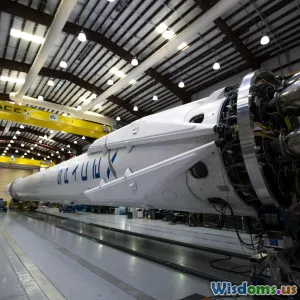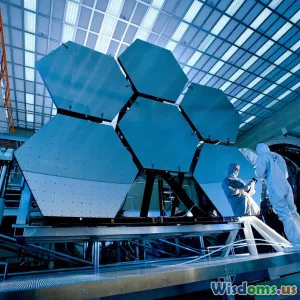
The Science Behind Electric Propulsion in Modern Spacecrafts
10 min read Explore the revolutionary science powering electric propulsion systems transforming modern spacecraft travel and exploration. (0 Reviews)
The Science Behind Electric Propulsion in Modern Spacecrafts
Space exploration has always challenged engineers and scientists to invent propulsion systems that are efficient, powerful, and reliable enough to journey beyond Earth. Among the most compelling advancements fueling this evolution is electric propulsion—a technology redefining how spacecraft travel through our solar system and beyond. But what exactly is electric propulsion, how does it work, and why is it becoming the choice for modern spacecraft? This article delves into the intricate science underpinning electric propulsion, exploring its mechanisms, benefits, types, and real-world usage.
Introduction: A New Era in Space Propulsion
Traditional chemical rockets, with their thundering bursts of power and short, intense thrusts, have been humanity's workhorse for lifting spacecraft off Earth and into space. Although chemically-fueled rockets provide necessary brute force, they are inefficient for sustained deep-space missions due to limited fuel capacity and poor fuel economy.
Electric propulsion systems present a compelling alternative. By leveraging electrical energy—typically generated by solar panels—these systems accelerate propellant to extremely high velocities, producing gentle but continuous thrust over extended periods. The outcome is engines with significantly higher fuel efficiency, allowing spacecraft to travel farther using less propellant.
The concept isn't new—electric propulsion's foundations trace back to the early-to-mid 20th century—but contemporary advancements in materials science, power electronics, and solar technology have matured these thrusters into practical spaceflight tools. To understand their transformative power, we must unpack the fundamental scientific principles at play.
Understanding the Physics of Electric Propulsion
Principles of Thrust and Specific Impulse
Thrust in any propulsion system results from Newton’s third law: every action has an equal and opposite reaction. Rocket engines expel mass at high velocity, pushing the vehicle forward. The effectiveness of propulsion is often measured by specific impulse (Isp), which gauges how efficiently a thruster uses its propellant.
Traditional chemical rockets have ISP values ranging approximately between 300-450 seconds. Electric propulsion systems frequently achieve ISPs of 1,500 to 4,000 seconds or more because they ionize propellant and expel ions at much higher velocities.
Ionization and Electromagnetic Acceleration
Electric propulsion uses electrical energy to ionize a neutral propellant—commonly xenon—turning atoms into positively charged ions. These ions are then accelerated by electric and magnetic fields, creating a high-speed ion stream expelled out the engine nozzle.
This process conserves propellant while achieving exhaust velocities far exceeding those deliverable by chemical combustion. The higher the exhaust velocity, the less propellant needed, enabling longer missions with limited onboard fuel.
The Role of Power Sources
Since these thrusters rely heavily on electric energy, reliable power generation and management systems are crucial. Most modern spacecraft use large solar arrays—a technology significantly advancing since the Apollo missions—to provide the necessary continuous energy supply, minimizing dependency on heavy chemical fuels.
Nuclear power sources have also been considered, offering higher power output, especially for missions farther from the Sun where solar energy diminishes.
Types of Electric Propulsion Systems
Several electric thruster designs have been developed, each with unique principles, advantages, and ideal mission types.
1. Ion Thrusters
Ion thrusters are among the earliest developed and most utilized electric propulsion systems. They function by ionizing xenon gas and accelerating the ions through electrostatic grids to generate thrust.
Example: NASA’s Dawn spacecraft used ion thrusters successfully to explore the asteroid belt, visiting Vesta and Ceres. The ion engine operated continuously for over 50,000 hours, showcasing endurance and fuel efficiency unheard of in conventional engines.
2. Hall Effect Thrusters
Hall thrusters create a magnetic field that traps electrons, which continuously ionize the propellant and accelerate ions outward. While offering somewhat lower specific impulses than ion thrusters (typically 1,000–2,000 seconds), Hall thrusters produce higher thrust levels, beneficial for faster orbit adjustments and station-keeping.
Example: European Space Agency and private satellites often use Hall Effect Thrusters for maneuvering in geostationary orbits.
3. Variable Specific Impulse Magnetoplasma Rocket (VASIMR)
An advanced technology under development, VASIMR uses radio waves to ionize and heat plasma before accelerating it with magnetic fields. The system can vary the exhaust velocity and thrust, offering adaptability for diverse missions.
Though experimental, VASIMR has potential applications in rapid Mars transfer missions requiring both high thrust and efficiency.
4. Electrospray Thrusters and Micro-propulsion
For small satellites and nanosats, electrospray thrusters provide precise, low-thrust propulsion by electrically extracting and accelerating ions or droplets from a liquid propellant. These systems enable fine attitude control with minimal power and propellant usage.
Advantages and Challenges of Electric Propulsion
Advantages
- Fuel Efficiency: Electric propulsion offers fuel efficiency up to ten times higher than traditional rockets, greatly reducing mission mass and costs.
- Long Duration Thrust: Continuous low-thrust operation is ideal for deep-space missions or maintaining precise orbits.
- Reduced Launch Mass: Less propellant needed means spacecraft can carry more instruments or reduce launch vehicle requirements.
- Enabling New Missions: These systems unlock missions impossible before, such as prolonged exploration of asteroids or interplanetary travel.
Challenges
- Low Thrust Output: Electric thrusters produce significantly lower thrust than chemical engines, unsuitable for heavy lift off from planetary surfaces.
- Power Dependence: Thruster operation hinges on power availability, demanding large solar arrays or compact nuclear power systems.
- Complexity and Longevity: Engineering robust thrusters that operate continuously for years without failure remains a demanding task.
Real-World Applications and Future Prospects
Current Missions Harnessing Electric Propulsion
- NASA’s Dawn Mission: Pioneered ion propulsion in interplanetary missions, demonstrating multi-target capability with high velocity increments.
- Boeing 702 Satellite Family: Employ Hall effect thrusters, prolonging mission lifetimes and enabling orbital flexibility.
- ESA’s BepiColombo: Equipped with electric propulsion, it's journeying to Mercury with a complex trajectory that chemical propulsion alone could not support.
Emerging Innovations
- Advanced Power Systems: Improvements in solar panel efficiency and development of compact nuclear reactors promise more powerful electric propulsion capabilities.
- Interstellar Missions: Concepts for missions to outer solar system or even interstellar space contemplate fusion-powered electric thrusters combined with ultra-high specific impulse.
- Hybrid Propulsion: Combining chemical and electric propulsion to leverage immediate high thrust and long-duration efficiency for flexible mission profiles.
Conclusion: A Propulsive Paradigm Shift
Electric propulsion epitomizes the fusion of physics, engineering, and space exploration ambition. By harnessing electrical energy to accelerate propellant to phenomenal speeds, these thrusters empower spacecraft to travel farther, longer, and more efficiently than ever before.
Although challenges remain—particularly in thrust magnitude and power supply—continued technological breakthroughs pave the way for electric propulsion systems to become the cornerstone of future spaceflight. From asteroid exploration to crewed Mars missions and beyond, the science behind electric propulsion is not just theoretical; it is actively transforming our capabilities in the cosmic frontier.
As we look towards a new era of interplanetary travel, understanding and supporting advancements in electric propulsion will be critical. This technology not only exemplifies human ingenuity but also fuels our quest to uncover the universe’s mysteries, inspiring scientists, engineers, and space enthusiasts alike.
“Electric propulsion offers the promise of enabling viable, cost-effective deep-space missions. It represents a paradigm shift in how we approach space travel.” — Dr. Moriba Jah, Aerospace Engineer
References & Further Reading
- NASA Glenn Research Center, Electric Propulsion: https://www.nasa.gov/centers/glenn/about/fs21grc.html
- ESA on BepiColombo Propulsion: https://www.esa.int/Science_Exploration/Space_Science/BepiColombo/Propulsion
- Jahn, R.G. (1968). Physics of Electric Propulsion. McGraw-Hill.
- Goebel, D.M. and Katz, I. (2008). Fundamentals of Electric Propulsion: Ion and Hall Thrusters. JPL/NASA.
Rate the Post
User Reviews
Popular Posts
















